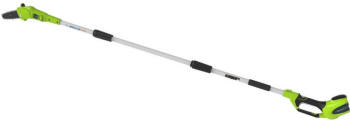 Tall branches and dense greenery frequently make for a delicate working environment. Greenworks’ 40V Pole Saw is has a 20 cm bar in addition to being lightweight, therefore allowing you to work at various heights with increased steadiness and performance. It has a detachable three-piece tool-less shaft for easy transport and storage. Our Pole Saw doesn’t only eliminate ladders by giving you the reach you need, but also removes another hazard: petrol. Greenworks – making life easier. User ManualIntended use Your Greenworkstools cordless pole pruner has been designed for pruning trees. This tool is intended for consumer use only. Your Greenworkstools charger has been designed for charging Greenworkstools batteries of the type supplied with this tool. Safety instructionsGeneral power tool safety warnings  Warning! Read all safety warnings and all instructions. Failure to follow all instructions may result in electric shock, fire and/or serious injury. Warning! Read all safety warnings and all instructions. Failure to follow all instructions may result in electric shock, fire and/or serious injury.
Save all warnings and instructions for future reference.
The term “power tool” in all of the warnings listed below refers to your mains operated (corded) power tool or battery operated (cordless) power tool.
1. Work area safety a. Keep work area clean and well lit. Cluttered and dark areas invite accidents.
b. Do not operate power tools in explosive atmospheres, such as in the presence of flammable liquids, gases or dust. Power tools create sparks which may ignite the dust or fumes.
c. Keep children and bystanders away while operating a power tool. Distractions can cause you to lose control. 2. Electrical safety a. Power tool plugs must match the outlet. Never modify the plug in any way. Do not use any adapter plugs with earthed (grounded) power tools. Unmodified plugs and matching outlets will reduce risk of electric shock.
b. Avoid body contact with earthed or grounded surfaces such as pipes, radiators, ranges and refrigerators. There is an increased risk of electric shock if your body is earthed or grounded.
c. Do not expose power tools to rain or wet conditions. Water entering a power tool will increase the risk of electric shock.
d. Do not abuse the cord. Never use the cord for carrying, pulling or unplugging the power tool. Keep cord away from heat, oil, sharp edges or moving parts. Damaged or entangled cords increase the risk of electric shock.
e. When operating a power tool outdoors, use an extension cord suitable for outdoor use. Use of a cord suitable for outdoor use reduces the risk of electric shock. 3. Personal safety a. Stay alert, watch what you are doing and use common sense when operating a power tool. Do not use a power tool while you are tired or under the influence of drugs, alcohol or medication. A moment of inattention while operating power tools may result in serious personal injury.
b. Use personal protective equipment. Always wear eye protection. Protective equipment such as dust mask, non-skid safety shoes, hard hat, or hearing protection used for appropriate conditions will reduce personal injuries.
c. Avoid accidental starting. Ensure the switch is in the off-position before connecting to power source and/or battery pack, picking up or carrying the tool. Carrying power tools with your finger on the switch or energising power tools that have the switch on invites accidents.
d. Remove any adjusting key or wrench before turning the power tool on. A wrench or a key left attached to a rotating part of the power tool may result in personal injury.
e. Do not overreach. Keep proper footing and balance at all times. This enables better control of the power tool in unexpected situations.
f. Dress properly. Do not wear loose clothing or jewellery. Keep your hair, clothing and gloves away from moving parts. Loose clothes, jewellery or long hair can be caught in moving parts.
g. If devices are provided for the connection of dust extraction and collection facilities, ensure these are connected and properly used. Use of dust collection can reduce dust-related hazards. 4. Power tool use and care a. Do not force the power tool. Use the correct power tool for your application. The correct power tool will do the job better and safer at the rate for which it was designed.
b. Do not use the power tool if the switch does not turn it on and off. Any power tool that cannot be controlled with the switch is dangerous and must be repaired.
c. Disconnect the plug from the power source and/or the battery pack from the power tool before making any adjustments, changing accessories, or storing power tools. Such preventive safety measures reduce the risk of starting the power tool accidentally.
d. Store idle power tools out of the reach of children and do not allow persons unfamiliar with the power tool or these instructions to operate the power tool. Power tools are dangerous in the hands of untrained users.
e. Maintain power tools. Check for misalignment or binding of moving parts, breakage of parts and any other condition that may affect the power tools operation. If damaged, have the power tool repaired before use. Many accidents are caused by poorly maintained power tools.
f. Keep cutting tools sharp and clean. Properly maintained cutting tools with sharp cutting edges are less likely to bind and are easier to control.
g. Use the power tool, accessories and tool bits etc. In accordance with these instructions, taking into account the working conditions and the work to be performed. Use of the power tool for operations different from those intended could result in a hazardous situation. 5. Battery tool use and care a. Recharge only with the charger specified by the manufacturer. A charger that is suitable for one type of battery pack may create a risk of fire when used with another battery pack.
b. Use power tools only with specifically designated battery packs. Use of any other battery packs may create a risk of injury and fire.
c. When battery pack is not in use, keep it away from other metal objects, like paper clips, coins, keys, nails, screws, or other small metal objects, that can make a connection from one terminal to another. Shorting the battery terminals together may cause bums or a fire.
d. Under abusive conditions, liquid may be ejected from the battery; avoid contact. If contact accidentally occurs, flush with water. If liquid contacts eyes, additionally seek medical help. Liquid ejected from the battery may cause irritation or burns. 6. Service a. Have your power tool serviced by a qualified repair person using only identical replacement parts. This will make sure that the safety of the power tool is maintained. Additional power tool safety warnings  Warning! Additional safety instructions for pole pruners Warning! Additional safety instructions for pole pruners
The intended use is described in this instruction manual. Do not use the tool for purposes not intended; for example do not use the tool to fell trees. The use of any accessory or attachment or performance of any operation with this tool other than those recommended in this instruction manual may present a risk of personal injury.
♦ Hold power tool by insulated gripping surfaces when performing an operation where the cutting tool may contact hidden wiring or its own cord. Contact with a “live” wire will also make exposed metal parts of the power tool “live” and give the operator an electric shock.
♦ Wear close fitting and protective clothing including a safety helmet with visor/goggles, ear protectors, non-skid safety footwear, protective bib trousers and strong leather gloves.
♦ Always position yourself out of the path of falling branches.
♦ The safe distance between a branch to be felled and bystanders, buildings and other objects is at least 2 1/2 times the length of the branch. Any bystander, building or object within this distance is at risk from being struck by the falling branch.
♦ Pre-plan a safe exit from falling trees or branches. Ensure the exit route is clear of obstacles that would prevent or hinder movement. Remember wet grass and freshly cut bark is slippery.
♦ Ensure someone is nearby (but at a safe distance) in case of an accident.
♦ Do not use the tool while standing in a tree, on a ladder or on any other unstable surface.
♦ Keep proper footing and balance at all times.
♦ Hold the tool firmly with both hands when the motor is running.
♦ Do not let the moving chain contact any object at the tip of the guide bar.
♦ Start cutting only with the chain moving at full speed.
♦ Do not attempt to enter a previous cut. Always make a fresh cut.
♦ Watch for shifting branches or other forces that could close a cut and pinch or fall into the chain.
♦ Do not attempt to cut a branch when the diameter of the branch exceeds the cutting length of the tool.
♦ Always remove the battery from the tool and place the chain cover over the chain when storing or transporting the tool.
♦ Keep the saw chain sharp and properly tensioned. Check the tension at regular intervals.
♦ Switch the tool off, allow the chain to stop and remove the battery from the tool before carrying out any adjustment, servicing or maintenance.
♦ Only use genuine replacement parts and accessories.
♦ Carry the pole pruner by the handle with the cutter blade stopped. When transporting or storing the pole pruner always fit the cutting device cover and dismantle it into its component parts. Proper handling of the pole pruner will reduce possible personal injury and injury to others.
Safety of others ♦ This appliance is not intended for use by persons (including children) with reduced physical, sensory or mental capabilities, or lack of experience and knowledge, unless they have been given supervision or instruction concerning the use of the appliance by a person responsible for the their safety.
♦ Children should be supervised to ensure that they do not play with the appliance. Vibration The declared vibration emission values stated in the technical data and the declaration of conformity have been measured in accordance with a standard test method provided by EN 60745 and may be used for comparing one tool with another. The declared vibration emission value may also be used in a preliminary assessment of exposure. Warning!
The vibration emission value during actual use of the power tool can differ from the declared value depending on the ways in which the tool is used. The vibration level may increase above the level stated. When assessing vibration exposure to determine safety measures required by 2002/44/EC to protect persons regularly using power tools in employment, an estimation of vibration exposure should consider, the actual conditions of use and the way the tool is used, including taking account of all parts of the operating cycle such as the times when the tool is switched off and when it is running idle in addition to the trigger time. Pruning Before attempting to prune a tree, ensure there are not bylaws or regulations that would prohibit or control the felling of the tree. ♦ Be aware of the direction a branch may fall. Consider all conditions that may affect the direction of fall, including:
- the length and weight of the branch to be cut
- the intended direction of fall
- any unusual heavy limb structure or decay
- the presence of surrounding trees and obstacles,
- including overhead lines
- the intertwinement with other branches
- the speed and direction of the wind.
♦ Consider access to the tree limb.
Tree branches are liable to swing towards the tree trunk. In addition to the user, any bystander, building or object below the branch is at risk of being struck by the branch. Warning symbols The following warning symbols are shown on the tool:  - Warning! To reduce the risk of injury, the user must read the instruction manual. - Warning! To reduce the risk of injury, the user must read the instruction manual.
 - Do not expose the tool to rain or high humidity. - Do not expose the tool to rain or high humidity.
 - Always wear the gloves when use the chain saw. - Always wear the gloves when use the chain saw.
 - Beware of falling objects. Keep bystanders away. - Beware of falling objects. Keep bystanders away.
 - Electrocution hazard. Keep at least 10 m away from overhead lines. - Electrocution hazard. Keep at least 10 m away from overhead lines.
 - Always wear head and eye protection. - Always wear head and eye protection.
 - Wear non-slip safety footwear. - Wear non-slip safety footwear.
 - Always wear the glasses when use the chain saw. - Always wear the glasses when use the chain saw.
 - Always wear the ear protector when use the chain saw. - Always wear the ear protector when use the chain saw.
 - Direction of rotation of the chain. - Direction of rotation of the chain.
 - Warning! Do not touch chain at the chip ejection point. - Warning! Do not touch chain at the chip ejection point.
Residual risks Additional residual risks may arise when using the tool which may not be included in the enclosed safety warnings. These risks can arise from misuse, prolonged use etc.
Even with the application of the relevant safety regulations and the implementation of safety devices, certain residual risks cannot be avoided. These include:
♦ Injuries caused by touching any rotating/moving parts.
♦ Injuries caused when changing any parts, blades or accessories.
♦ Injuries caused by prolonged use of a tool. When using any tool for prolonged periods make sure you take regular breaks.
♦ Impairment of hearing.
♦ Health hazards caused by breathing dust developed when using your tool (example:- working with wood, especially oak, beech and MDF). Additional safety instructions for batteries and chargers Batteries ♦ Never attempt to open for any reason.
♦ Do not expose the battery to water.
♦ Do not expose the battery to heat.
♦ Do not store in locations where the temperature may exceed 40°C.
♦ Charge only at ambient temperatures between 10°C and 40°C.
♦ Charge only using the charger provided with the appliance/tool. Using the wrong charger could result in an electric shock or overheating of the battery.
♦ When disposing of batteries, follow the instructions given in the section “Protecting the environment”.
♦ Do not damage/deform the battery pack either by puncture or impact, as this may create a risk of injury and fire.
♦ Do not charge damaged batteries.
♦ Under extreme conditions, battery leakage may occur. When you notice liquid on the batteries, carefully wipe the liquid off using a cloth. Avoid skin contact.
♦ In case of skin or eye contact, follow the instructions below. Warning! The battery fluid may cause personal injury or damage to property. In case of skin contact, immediately rinse with water. If redness, pain or irritation occurs seek medical attention. In case of eye contact, rinse immediately with clean water and seek medical attention. Chargers Your charger has been designed for a specific voltage. Always check that the mains voltage corresponds to the voltage on the rating plate. Warning! Never attempt to replace the charger unit with a regular mains plug. ♦ Use your Greenworkstools charger only to charge the battery in the appliance/tool with which it was supplied. Other batteries could burst, causing personal injury and damage.
♦ Never attempt to charge non-rechargeable batteries.
♦ If the supply cord is damaged, it must be replaced by the manufacturer or an authorised Greenworks tools Service Centre in order to avoid a hazard.
♦ Do not expose the charger to water.
♦ Do not open the charger.
♦ Do not probe the charger.
♦ The charger must be placed in a well ventilated area when charging. Symbols on the charger The following symbols are found on your charger:  - Your charger is double insulated; therefore no earth wire is required. Always check that the mains voltage corresponds to the voltage on the rating plate. Never attempt to replace the charger unit with a regular mains plug. If the cord is damaged, it must be replaced by the manufacturer or an authorised Greenworkstools Service Centre in order to avoid a hazard. - Your charger is double insulated; therefore no earth wire is required. Always check that the mains voltage corresponds to the voltage on the rating plate. Never attempt to replace the charger unit with a regular mains plug. If the cord is damaged, it must be replaced by the manufacturer or an authorised Greenworkstools Service Centre in order to avoid a hazard.
 - The charger is intended for indoor use only. - The charger is intended for indoor use only.
 - Read the instruction manual before use. - Read the instruction manual before use.
Features1. On/off switch
2. Lock-off button
3. Main handle
4. Saw head
5. Sprocket cover
6. Guide bar
7. Chain
8. Chain sheath
9. Extension tube
10. Battery
11. Oil tank Fig. A 
12. Charger
Assembly Warning! Before assembly, remove the battery from the tool. Fitting and removing the battery (fig. B) 
♦ To fit the battery (11), line it up with the receptacle on the tool. Slide the battery into the receptacle and push until the battery snaps into place.
♦ To remove the battery, push the release button (13) while at the same time pulling the battery out of the receptacle. Warning! To prevent accidental operation, ensure that the battery is removed and that the chain sheath is in placed on the saw chain before performing the following operations. Failure to do this could result in serious personal injury. Fitting the saw head (fig. C) 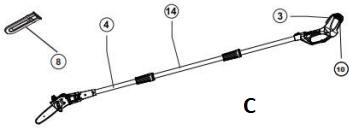
The saw head can be fitted directly to the handle in order to achieve standard reach. ♦ Align the groove on the outside of the coupling end of the handle (3) with the tongue on the inside of the coupling end of the saw head (4). Push the saw head (4) onto the handle (3).
♦ Slide the collar (14) upwards and rotate it counter-clockwise until it is fully tightened. Warning! Periodically check the connections to ensure that they are tightened securely. Extending the saw head (fig. D) 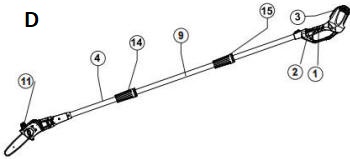
The maximum reach can be achieved by fitting the extension tube (9) between the saw head (4) and the handle (3). ♦ Align the groove on the outside of the coupling end of the handle (3) with the tongue on the inside of the coupling end of the extension tube (9).
♦ Push the extension tube (9) onto the handle (3).
♦ Slide the collar (15) upwards and rotate it counter-clockwise until it is fully tightened.
♦ Align the groove on the outside of the coupling end of the extension tube (9) with the tongue on the inside of the coupling end of the saw head (4).
♦ Push the saw head (4) onto the extension tube (9).
♦ Slide the collar (14) upwards and rotate it counter-clockwise until it is fully tightened. Warning! Periodically check the connections to ensure that they are tightened securely. Removing the saw head (fig. C & D) If the extension tube (9) is fitted, the saw head must be removed first. ♦ To remove the saw head (4), rest the handle (3) on the ground, loosen the collar (14) and take off the saw head. UseWarning! Let the tool work at its own pace. Do not overload. Charging the battery (fig. A) The battery needs to be charged before first use and whenever it fails to produce sufficient power on jobs that were easily done before.
The battery may become warm while charging; this is normal and does not indicate a problem. Warning! Do not charge the battery at ambient temperatures below 10°C or above 40°C. Recommended charging temperature: approximately. 24°C. Note: The charger will not charge a battery if the cell temperature is below approximately 10°C or above 40°C. ♦ The battery should be left in the charger and the charger will begin to charge automatically when the cell temperature warms up or cools down.
♦ To charge the battery (10), remove it from the tool and insert it into the charger (12). The battery will only fit into the charger in one way. Do not force. Be sure that the battery is fully seated in the charger.
♦ Plug in the charger and switch on at the mains.
♦ The charging indicator (24) will iulluminate.
The charge is complete when the charging indicator (24) lights green continuously. The charger and the battery can be left connected indefinitely with the LED illuminated. The LED will change to red state as the charger occasionally tops off the battery charge. The charging indicator (24) will be lit as long as the battery is connected to the plugged-in charger.
♦ Charge discharged batteries within 1 week. Battery life will be greatly diminished if stored in a discharged state. Leaving the battery in the charger The charger and battery pack can be left connected indefinitely with the LED lit. The charger will keep the battery pack fresh and fully charged. Charger diagnostics If the charger detects a weak or damaged battery, the charging indicator (24) will flash red at a fast rate. Proceed as follows:
♦ Re-insert the battery (10).
♦ If the charging indicator continues flashing red at a fast rate, use a different battery to determine if the charging process works properly.
♦ If the replaced battery charges correctly, the original battery is defective and should be returned to a service centre for recycling.
♦ If the new battery gives the same indication as the original battery, take the charger to be tested at an authorised service centre. Note: It may take as long as 60 minutes to determine that the battery is defective. Switching on and off (fig. E) 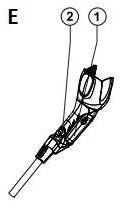
For your safety, this tool is equipped with a double switching system. This system prevents starting the tool inadvertently. Switching on ♦ Push the lock-off button (2) backward using your thumb and at the same time squeeze the on/off switch (1).
♦ Release the lock-off button (2). Switching off ♦ Release the on/off switch (1). Warning! Never attempt to lock a switch in the on position. Pruning (fig. F) 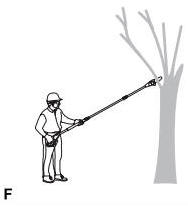
♦ Make sure the tool is running at full speed before making a cut.
♦ Hold the tool firmly in place to avoid possible bouncing or sideways movement of the tool.
♦ Guide the tool through the branch using light pressure. When cutting heavy branches, where a partial cut may splinter and damage the tree, proceed as follows:
- Make the first cut 15 cm from the tree trunk on the underside of the limb. Use the top of the guide bar (6) to make this cut.
- Cut one third through the diameter of the limb. Then cut down from the top. Cleaning, maintenance and storageYour Greenworkstools corded/cordless appliance/tool has been designed to operate over a long period of time with a minimum of maintenance.
Continuous satisfactory operation depends upon proper tool care and regular cleaning. Warning! Before performing any maintenance on corded/cordless power tools:
♦ Switch off and unplug the appliance/tool
♦ Or switch off and remove the battery from the appliance/tool if the appliance/tool has a separate battery pack
♦ Or run the battery down completely if it is integral and then switch off
♦ Unplug the charger before cleaning it. Your charger does not require any maintenance apart from regular cleaning. Regularly clean the ventilation slots in you appliance/tool/ charger using a soft brush or dry cloth.
Regularly clean the motor housing using a damp cloth. Do not use any abrasive or solvent-based cleaner.
Regularly open the chuck and tap it to remove any dust from the interior (when fitted). After use and before storage ♦ Regularly clean the ventilation slots with a clean, dry paint brush.
♦ To clean the tool, use only mild soap and a damp cloth. Never let any liquid get inside the tool and never immerse any part of the tool into liquid.
♦ Remove debris using a hard brush.
♦ Lubricate the chain with oil. Installing and removing the saw chain (fig. G & H) 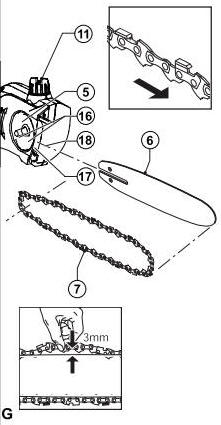
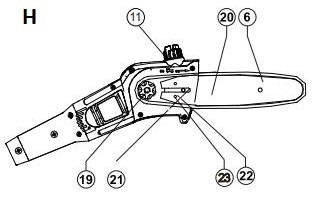
Warning! Always wear protective gloves when installing or removing the saw chain. The saw chain is sharp and can cut you when it is not running. ♦ Place the tool on a firm and stable surface.
♦ Loosen the screws (16) .
♦ Remove the screws.
♦ Remove the sprocket cover (5).
♦ Turn the screw (18) counterclockwise to allow the guide bar (6) to recede and to reduce the tension on the saw chain (7).
♦ Remove the old saw chain from the sprocket (19) and the guide bar (6).
♦ Place the new saw chain in the groove of the guide bar and around the sprocket. Make sure that the teeth are facing the correct direction by matching the arrow on the saw chain with the arrow on the housing.
♦ Make sure that the slot (20) in the guide bar is over the location pins (21) and that the hole (22) below the slot is located over the adjustment pin (23).
♦ Re-fit the sprocket cover (5) and the screws (16).
♦ Tighten the screws (16).
♦ Adjust the chain tension as described below. Checking and adjusting the chain tension (fig. G) ♦ Check the saw chain tension. The tension is correct when the saw chain (7) snaps back after being pulled away 3 mm from the saw chain bar with light force from the middle finger and thumb. There should be no 'sag' between the guide bar (6) and the saw chain (7) on the underside. To adjust the tension:
♦ Loosen the screws (16).
♦ Turn the screw (18) clockwise. Warning! Do not over-tension the chain as this will lead to excessive wear and will reduce the life of the bar and chain. ♦ Once the chain tension is correct, tighten the screws (16). Warning! When the saw chain is new, check the tension frequently during the first two hours of use as a new saw chain stretches slightly. Oiling the chain The saw chain must be oiled before each use and after cleaning using only the correct grade of oil (cat. no. A6027).
♦ Oil the whole saw chain (7) evenly. Storage When the tool will not be used for several months, ideally leave the battery connected to the charger.
Otherwise proceed as follows:
♦ Fully charge the battery.
♦ Remove the battery from the tool.
♦ Store the tool and battery in a secure and dry location.
♦ The storage temperature must always remain in the range of +10°C to +40°C. Place the battery on a level surface.
♦ Before using the tool after prolonged storage, fully charge the battery again. Protecting the environment Separate collection. This product must not be disposed of with normal household waste. Should you find one day that your Greenworkstools product needs replacement, or if it is of no further use to you, do not dispose of it with household waste. Make this product available for separate collection. Separate collection of used products and packaging allows materials to be recycled and used again. Re-use of recycled materials helps prevent environmental pollution and reduces the demand for raw materials. Batteries At the end of their useful life, discard batteries with due care for our environment:
♦ Do not short-circuit the battery terminals.
♦ Do not dispose of the battery(s) in a fire as this may result in a risk of personal injury or an explosion.
♦ Run the battery down completely, then remove it from the tool.
♦ Batteries are recyclable. Place the battery(s) in a suitable packaging to ensure that the terminals cannot be short-circuited. Take them to any authorised repair agent or a local recycling station.
Technical data 20157 Input voltage: 40 Vdc
No-load chain speed: 7,8 m/s
Max cutting length: 20 cm
Weight: 4,7 kg
Chain Oil tank capacity: 50 ml Battery 29717/29727 Voltage: 40 Vdc
Capacity: 73 / 146 Wh
Type: Li-Ion Charger 29417/29447 Input voltage: 100-240V Vac
Output voltage: 40 Vdc
Output current: 2000 mA Level of sound pressure according to EN ISO 11680-1: Sound pressure (LpA ) 87.7 dB(A), uncertainty (K) 3 dB(A) Level of sound power according to EN ISO 3744: Sound power (LWA ) 103 dB(A), uncertainty (K) 3 dB(A) Vibration total values (triax vector sum) according to EN 60745: Cutting freshly felled softwood (ah,w) = <2.5 m/s2 Uncertainty (K) 1.5 m/s2 TroubleshootingProblem / Possible cause / RemedyBar and chain running hot and smoking.
1. Check chain tension for overtightened condition.
● Tension chain.
● Refer to Chain Tension earlier in this manual. 2. Bar lube reservoir empty.
● Check bar lube reservoir. Motor runs, but chain is not rotating.
1. Chain tension too tight.
● Retention chain. Refer to Chain Tension earlier in this manual. 2. Check guide bar and chain assembly.
● Refer to Replacing the Bar and Chain earlier in this manual. 3. Check guide bar and chain for damage.
● Inspect guide bar and chain. | 